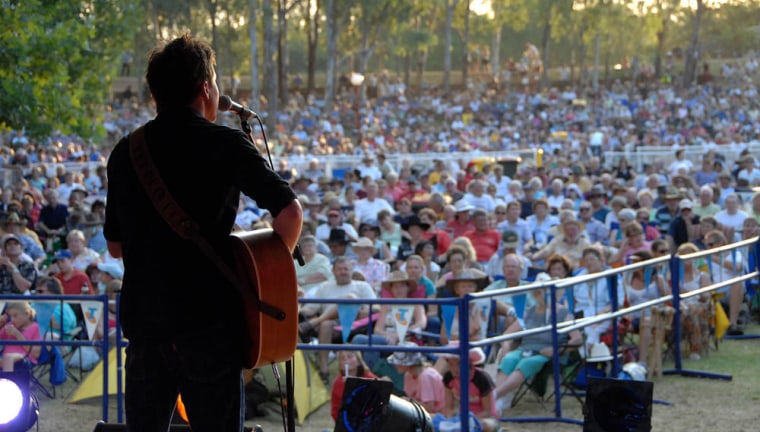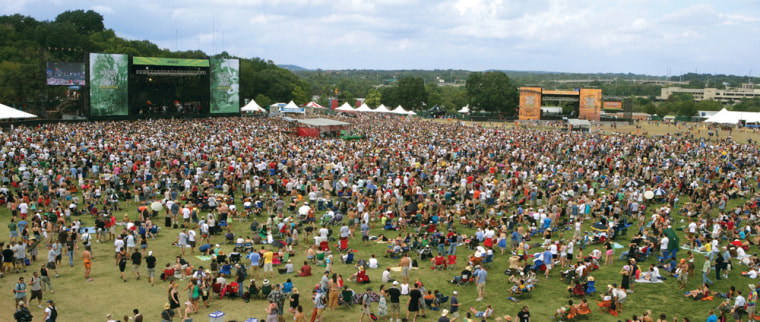It’s a balmy night beside the Caribbean and thousands of people are gathered on a well-worn cricket pitch, not to watch men in white take wickets, but to dig the cool tunes of the annual In the three years since its birth, Plymouth has become Tobago’s biggest outdoor party and cultural outpouring. Jazz is but a small part of a heady blend that includes all sorts of roots music—reggae, calypso, soca, funk and blues—a melodious stew that attracts music fans from all around the West Indies and (if the number of private jets parked on the tarmac at Crown Point Airport is any indication) an increasing number of high-fliers from overseas.
Flush with funds from the oil and gas fields of sister island Trinidad, the festival’s private and public sponsors attract A-list entertainers to their tropical island paradise, not just golden oldies like Stevie Wonder, Sting and Al Green, but hot young upstarts like Sean Paul, who swept away the 2007 festival crowd with his unabashedly sexy Jamaican dance hall hits.
A mellow mood prevails as people down dark rum and Carib beer, munch “bake & shark” and other island food from stalls around the edge of the cricket pitch, and groove until well past midnight beneath a warm star-filled sky. Days are set aside for snoozing, snorkeling and sunning on the island’s fabulous white-sand strands... often in close proximity to the very people you were swooning over the previous evening. Because one of the advantages of a big-league music fest on such a tiny island is the small-town atmosphere that permeates throughout. Yep, that’s Sean Paul and his gal (one of the back-up dancers) sleeping in the room right beside yours... and yes, that is Diana Ross staying in the villa across the street ... and Richard Branson—did you meet him at the after-party last night? So down-to-earth for a billionaire.
Plymouth is but one example of a growing global phenomenon. Music festivals are breaking out all over as a means to attract fans to places they might otherwise never go, a way for people far beyond the Sunset Strip and London’s West End to express their musicality, and a chance for smaller genres to grab the limelight, if only for a few days or weeks. “Festivals bring people together, help invigorate young people’s interest in local culture, help the artists themselves to meet and learn from each other, and promote a new kind of culturally conscious tourism,” event director Yusuf Mahmoud told the visiting press during this year’s in Zanzibar.
“I think the boom in festivals around the world has been a combination of things,” says Joe Fletcher, who books talent for musical events all around the world. “First, music fans love live music and enjoy the chance to get together with other fans of their favorite artists. Secondly, as record sales decline and global superstars are rarer, the idea of letting music lovers hear a variety of acts is very attractive. In England alone there are now hundreds of festivals, big and small. ”
Woodstock tends to get all the credit, but the granddaddy of them all was Monterey Pop two year prior (1967). The event was the first to raise musical festivals to the status of cultural watersheds, and it proved what could be accomplished when you combined cash and creativity (and perhaps just a wee bit of acid). Jimi Hendrix, the Who, Simon & Garfunkel, Jefferson Airplane and Janis Joplin are just a few of the 32 acts that performed over the three days of Monterey.
Nowadays there are festivals on every continent (save Antarctica) and nearly every country. And ambience has traveled well beyond Yasgur’s Farm to festivals perched on the edge of the Sahara Desert, on the shores of the Indian Ocean, in the streets of and the cobblestone streets of Europe. Festival amenities have changed drastically, too. Gone are the days when a roll in the mud and impromptu head shop were all you could find away from the music, replaced in many cases by gourmet food tents, designer apparel stalls, air-conditioned restrooms and even mini-spas.

According to San Diego Union-Tribune music critic George Varga, who’s been attending festivals since 1970, the controversial Woodstock revival in 1999 proved the death knell for huge, chaotic, storm-the-fences events. “Festivals tend to be smaller and more contained these days, with a much sharper focus. You basically have two kinds of festivals — events like Ozzfest that are designed purely for a specific audience and festivals that appeal to a wide variety of musical tastes like "
Varga notes that the current formula consists of a half-dozen big names each day as well as dozens of smaller acts that reflect regional music and generally lesser well-known. “Big acts draw the crowds, who are then exposed to all of this great music they wouldn't otherwise hear.”

Given the growing popularity of the best fests, it’s advisable to book your tickets, hotel and airfare at least a year in advance. Although online ticket clearinghouses often hawk festival tickets, the best course is usually the festival web site. Some festivals now offer combined ticket, accommodation and/or transportation packages that can range from something as simple as a ferry ride and a camping permit for the Isle of Wight, to round-trip airfare and a luxury hotel suite in Morocco. If you’re going a la carte, it’s always advisable to sleep within walking distance of the festival grounds. If that’s not possible, avoid traffic hassles by pre-arranging private transport to and from the events.
“If fans are planning to attend a festival, I would recommend finding out as much as you can about it [beforehand],” says Fletcher. “Have a designated spot to meet up with friends in case you get separated, be prepared for some delays—no need to get stressed out if traffic is a little slow. Dress in layers as weather may go from very hot in the day to cool in the evenings, bring sunscreen and for God’s sake, wear comfortable shoes!”
Varga has his own advice for getting the most out of a music festival: “Be open to music you don’t know. Follow your ears and experience the thrill of discovering something completely new or different. And when you’re at a festival with multiple stages and performers, relax and don't try to see it all. Think small, mark down a few things you really want to hear, and leave time for wandering around.”
We’ve scoured the globe to uncover ten of today’s coolest yearly music festivals, plus some of the best places to stay and insider tips on tickets and transportation. Enjoy.
